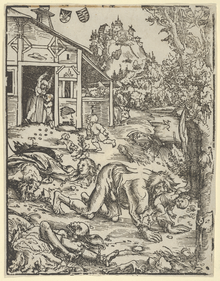Lycanthropy

Lycanthropy ( old Greek λύκος lýkos "wolf" and ἄνθρωπος ánthrōpos , "human") describes the transformation of a person into a werewolf (wolf man), as it occurs in legend, fairy tales and fiction. Changes in shape between humans and animals in general are summarized under the term therianthropy (e.g. in predatory animals such as bears , lions or leopards ). The term is also occasionally used in connection with vampirism .
history
In ancient Greece there was the legend of King Lykaon of Arcadia , who was transformed into a wolf by Zeus because of the sacrifice of his child.
In the early modern period , witchcraft was often blamed for lycanthropy within Europe .
Legend has it that when the werewolf walked as a human, it could have its wolf skin inside.
In the 15th and 16th centuries, lycanthropy was edited monographically. She was seen as being obsessed with the devil. Thus, according to the Malleus maleficarum , the werewolf was not a real animal and not a transformed human, but an illusion created by the devil. Thomas Aquinas saw demon-generated pseudo-creatures in the werewolves, which can be reconciled with obsession with the devil. He considered an actual transformation to be incompatible with the divine laws of nature.
The idea of lycanthropy finds its modern continuation in the so-called shape shifter in science fiction and fantasy literature.
Relation to vampirism
Rejuvenated vampirism, which appeared in the 17th and early 18th centuries, is often viewed as a continuation of lycanthropy. The relationship between werewolf and vampire becomes clear in the term "wudodalak" in all its subspecies. The word "wurdalak", which is common in both Greek and Slavic languages for werewolf and vampire, means wolf-haired. In Serbia it is “vukodlak”, in Poland “wilkolak”, in Bulgaria and Slovenia “vrkolak” and in Belarus it is “wawkalak”. In vampire tales, the mutated werewolf turns into a vampire, an immediate corpse, after his death.
Attempts to explain
Various causes have been assumed for the idea of lycanthropy:
- The ethnology of religion sees in lycanthropy an urgent disintegration of the old wolf mythology in psychopathological areas . Today we speak of some form of mental illness.
- The phenomenon of hypertrichosis , which is mostly based on genetic causes, leads to excessive hair growth. Those affected are sometimes referred to as "wolf people". In earlier centuries so-called hair people (see also hirsutism ) were exposed to the curiosity of their surroundings in many cases. It can be assumed that many only ventured out of the house at night or were let out by their parents. So they could only be seen when the moon was full.
- The wolf has been heavily associated with sexual symbolism in various cultures. One example is the fairy tale of Little Red Riding Hood , in which many interpretations see the representation of male sexuality in the form of the wolf. Sexuality lets the “animalistic side” of the man emerge, he “becomes an animal”, namely a wolf.
literature
- Michael Stolberg: Lycanthropy . In: Der Neue Pauly 15/1 (2001), Col. 243-246 (Lit.).
- Klaus Völker (ed.): Werewolves and other animal men. Seals and documents. Suhrkamp (among others), Frankfurt a. M. 1994, ISBN 3-518-38811-8 .
- Wilhelm Hertz : The Werewolf. Contribution to the saga. Reprinted by Sendet , Vaduz 1995, ISBN 3-500-26840-4
- Elmar M. Lorey : Henrich the werewolf. A story from the time of the witch trials. With documents and analyzes. Anabas, Frankfurt a. M. 1998, ISBN 3-87038-297-X .
- Eva Hackenbroch: Lycanthropy. Myth, superstition, disease. A contribution to the history of psychopathological terms . Med. Diss. Cologne 1968.
- Kathryn A. Edwards (ed.): Werewolves, witches, and wandering spirits. Traditional belief & folklore in early modern Europe. Truman State Univ., Kirksville, Mo. 2002.
- Richard Noll (Ed.): Vampires, werewolves, and demons. Twentieth century reports in the psychiatric literature. Brunner / Mazel, New York 1992.
- Robert Eisler : Man Into Wolf. An anthropological interpretation of sadism, masochism, and lycanthropy. New York 1951.
- Nadine Metzger: Wolf people and nocturnal visits. To locate premodern concepts of lycanthropy and ephialtes in terms of cultural history. Gardez, Remscheid 2011, ISBN 978-3-89796-233-0 .
- Keck, Pope, Hudson, McElroy, Kulick: Lycanthropy: alive and well in the twentieth century. in: Psychol Med. February 1988; 18 (1); Pp. 113-20.
See also
Individual evidence
- ↑ Markus Heitz: Vampires! Vampires! - Everything about bloodsuckers . Piper Verlag, Munich 2008. pp. 136-137